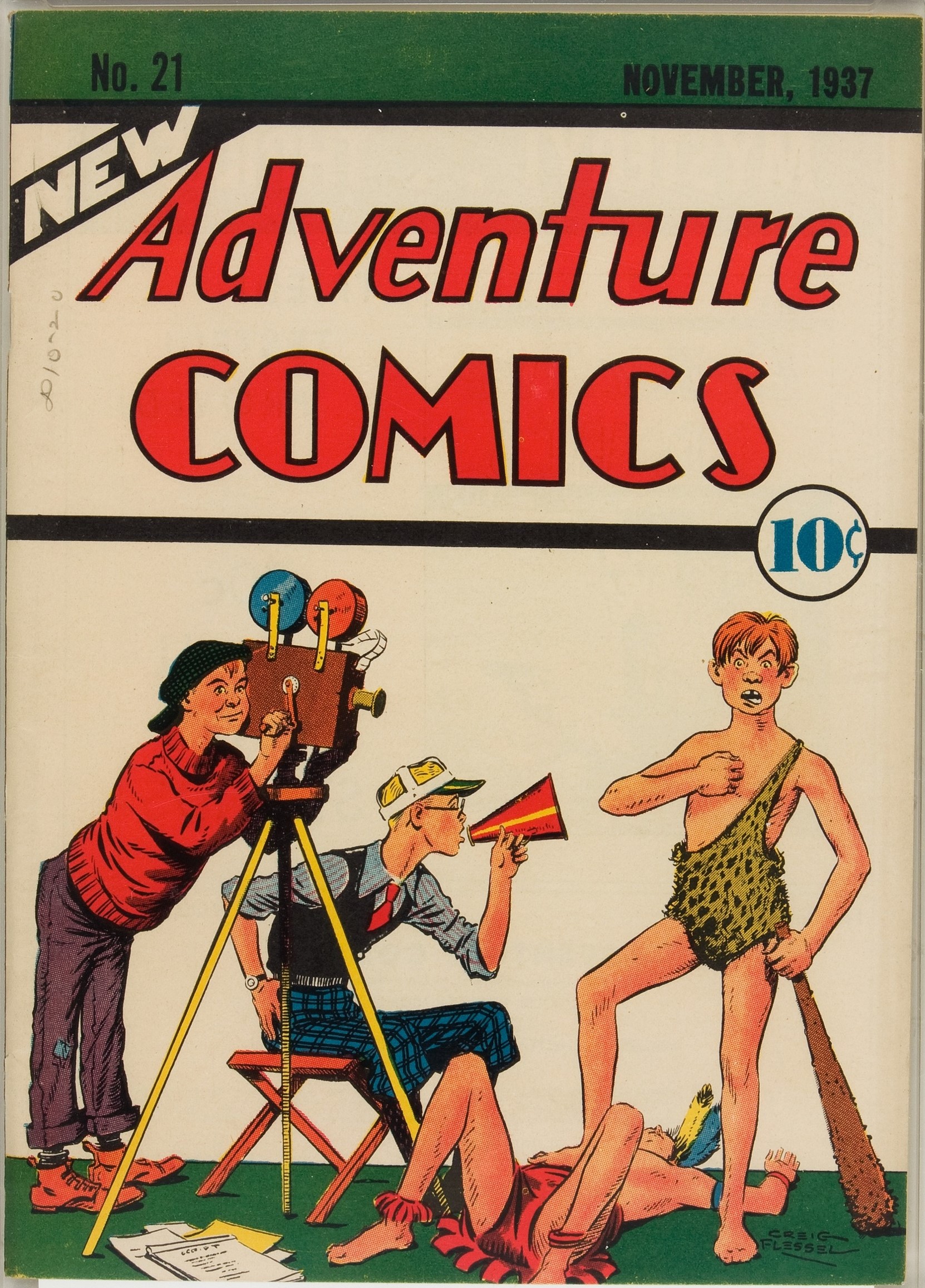 New Adventure Comics #21, with a November date most likely appeared sometime in late October, 1937. Another great cover by Creig Flessel shows a group of boys filming a jungle hero. It’s a bit of an anomaly since the vanquished person appears to be Native American. The composition, penciling and story told in illustrative form are excellent as well as humorous—a characteristic of Flessel’s.
New Adventure Comics #21, with a November date most likely appeared sometime in late October, 1937. Another great cover by Creig Flessel shows a group of boys filming a jungle hero. It’s a bit of an anomaly since the vanquished person appears to be Native American. The composition, penciling and story told in illustrative form are excellent as well as humorous—a characteristic of Flessel’s.
The November edition of Detective Comics #9 is advertised on the inside cover in black and white. The indicia below indicates that MWN is still publisher and editor with Whitney Ellsworth and Vincent Sullivan continuing as associate editors.
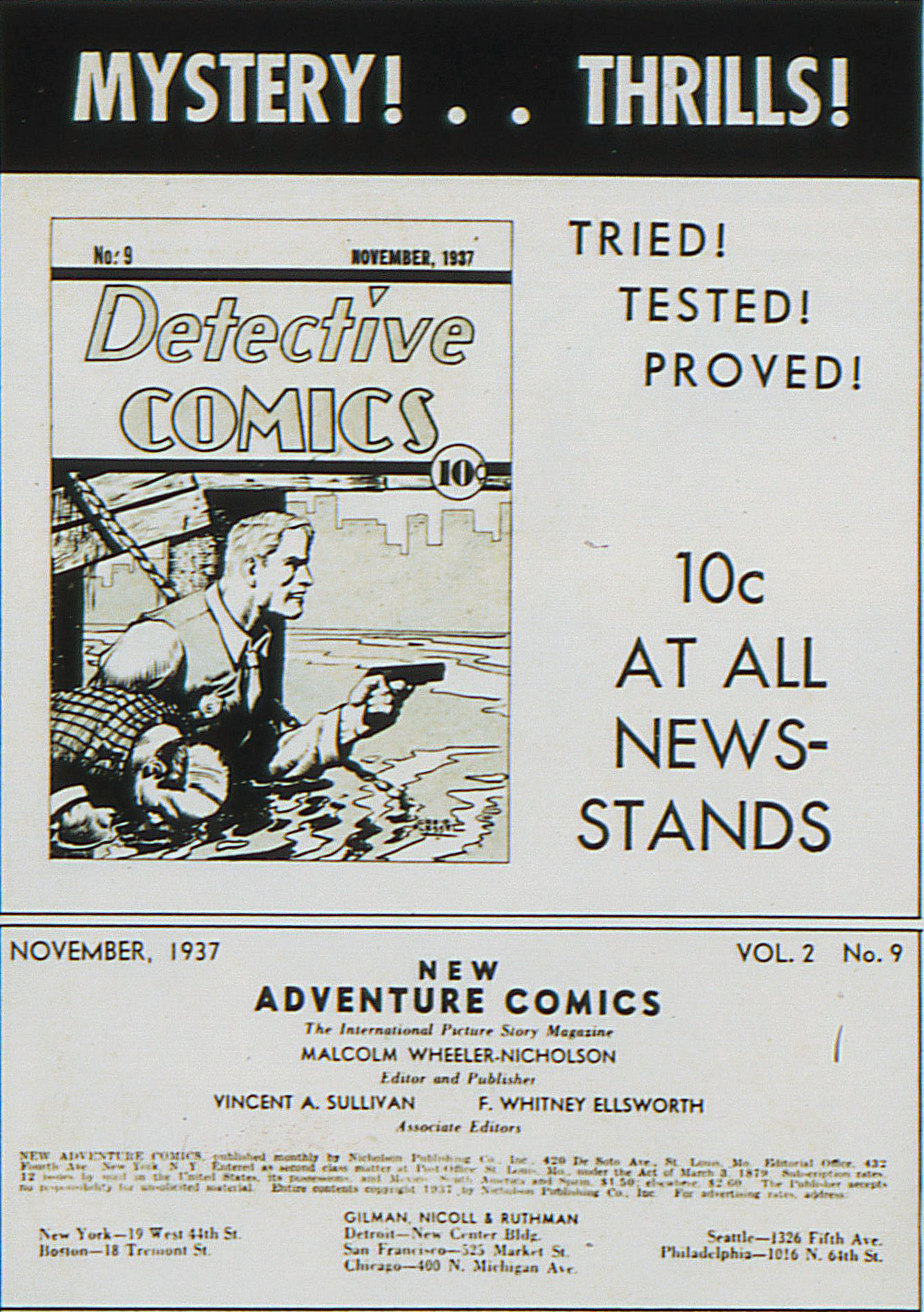
Of the 19 comics featured only 3 are new. The rest are continuations of stories or characters by regular artists.
Homer Fleming has two features, the continuing story of “Captain Jim of the Texas Rangers” and the continuing story of “Sandor and the Lost Civilization.” Fleming’s nicely executed artwork tends towards an illustrative style. In Captain Jim, there is a lot of explanatory lettering at the bottom of the panels in addition to the dialogue that often doesn’t fit as well with the illustration. It makes me wonder if he was given an outline, drew the panels and then the dialogue was added in. There is no dialogue in the Sandor story. I’m willing to guess someone else wrote the story–a typical story of the romantic lost civilization tales of this period. Both are in color.
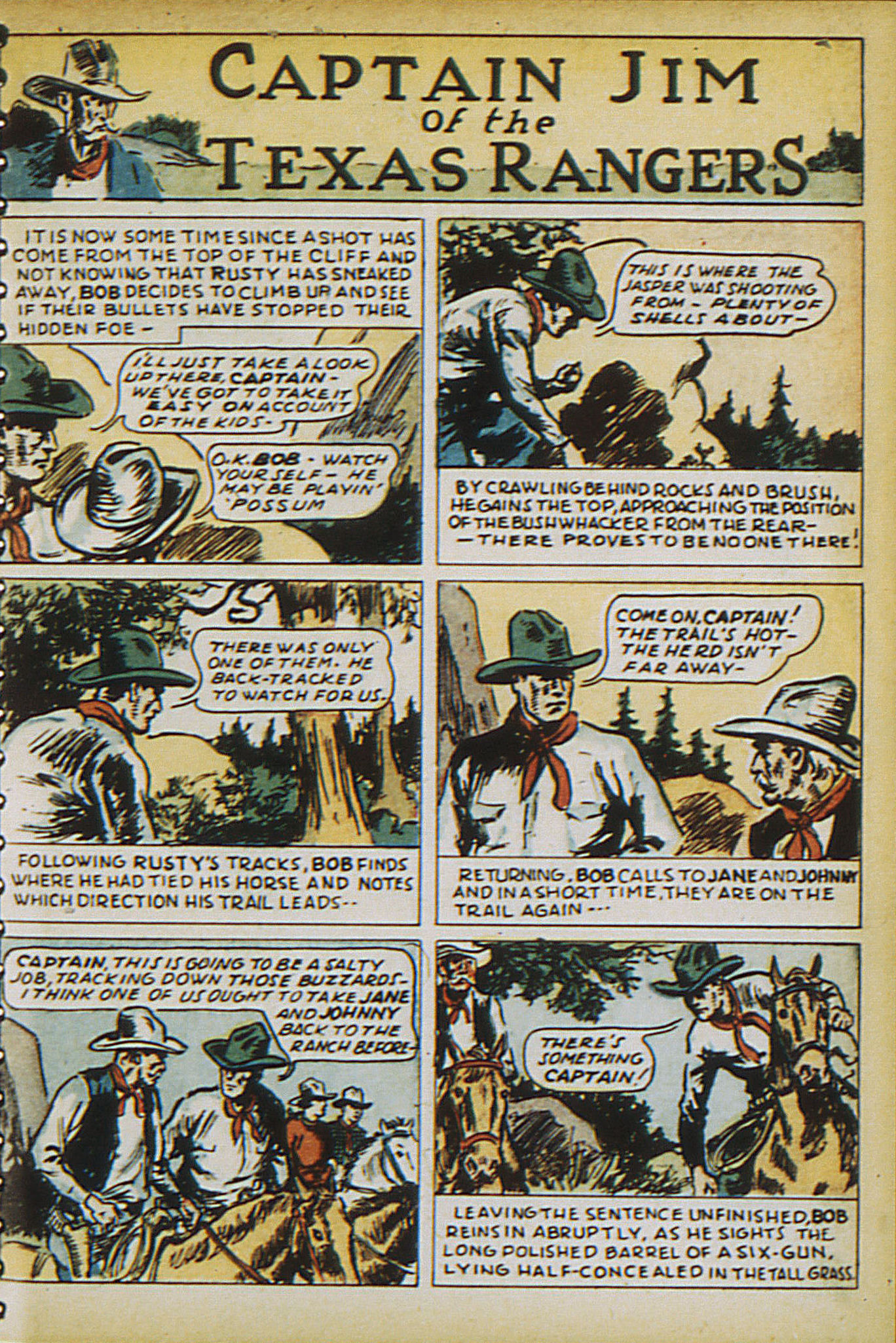
The Major has 3 credits and a possible fourth and who knows what else. Tom Hickey continues to draw the ongoing tale of “The Golden Dragon” in color from a pulp adventure story by the Major. I love the artwork and the story is full of action. However, again there is a lot more explanatory dialogue than needed. The opening panel is particularly evocative with the camels against the desert night sky.
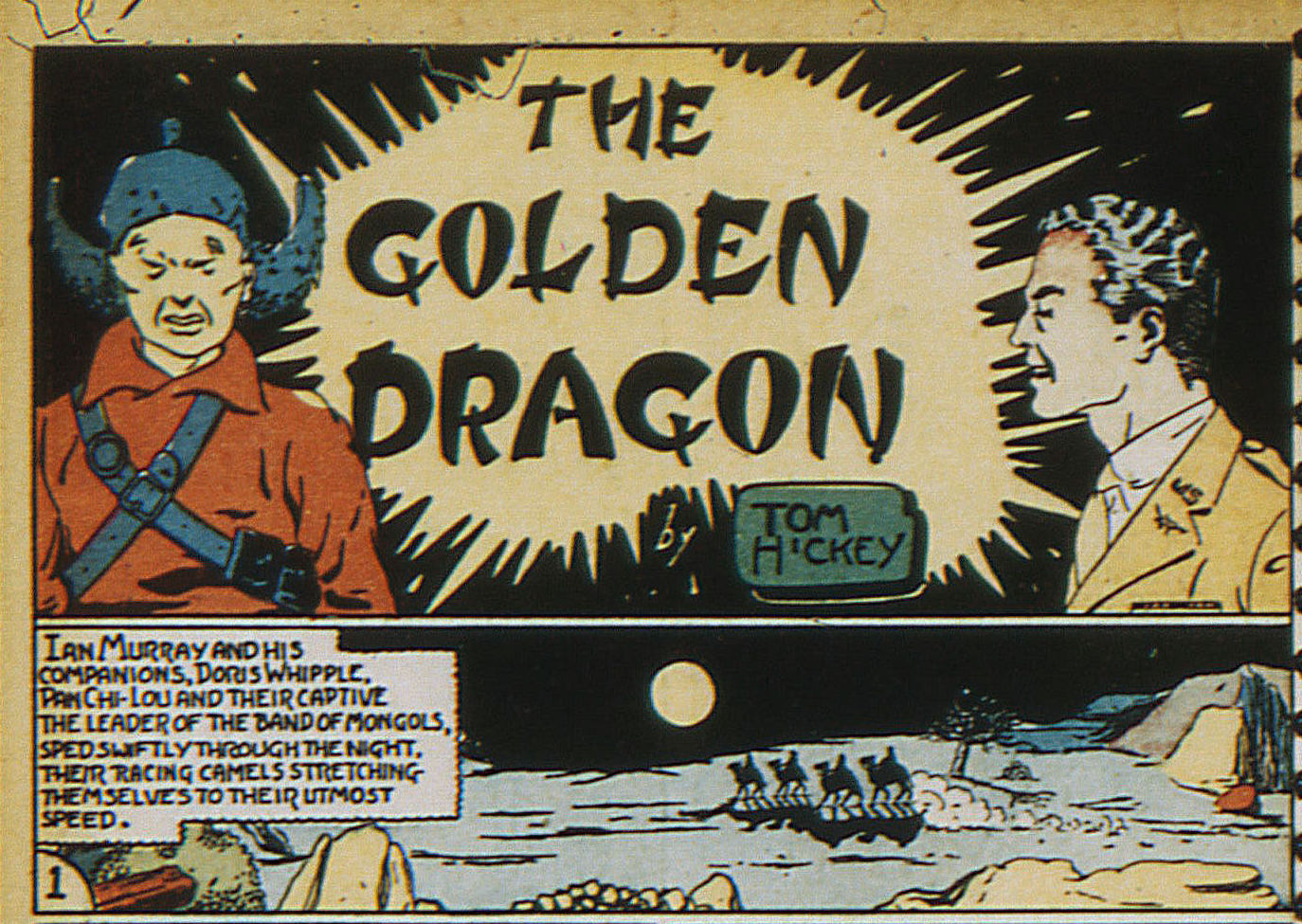
Alex Blum as “Anthony” continues drawing “The Vikings” most likely from an outline of the story from the Major. It is rendered in black and white with red. Given the number of comics in this issue in black and white and some with red, it’s a good bet that money was an issue. This comic is also done in illustrative style with the story at the bottom of the panel.
Munson Paddock, about whom there has been controversy as to his/her gender, is one of my favorite artists. His style is unique and evocative. He continues illustrating the Major’s pulp adventure story, “The Monastery of the Blue God,” originally published as “The Monastery of the Blue Death,” in The Popular Magazine, April 1930. As I have noted previously there are a number of autobiographical details in the story and the comic. The comic is in black and white and red.
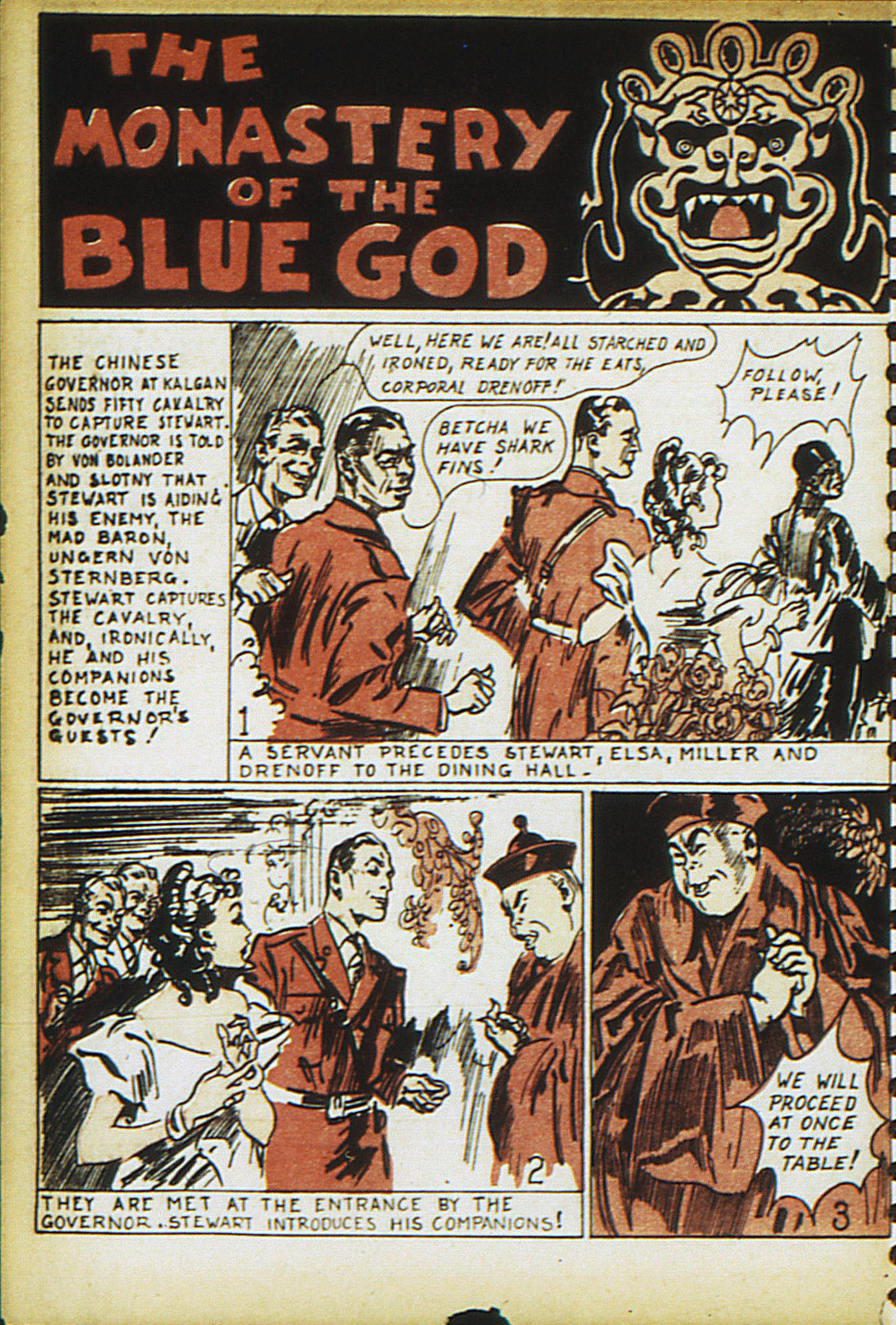
“She” from the H. Rider Haggard novel is illustrated by Sven Elven, one of the great artists of this period and most likely from a script by MWN. It is in black and white and red. “She” is such a strange novel and an odd choice in some ways but it is also in the vein of sci-fi and fantasy, which is part of the pulp/comic genre.
A continuing classic tale, Merna Gamble illustrates “A Tale of Two Cities“ by Charles Dickens and I’m willing to bet from what little is known about her that she also did the story. It’s done in classic illustrative style with the story at the bottom of the panel however, it’s so well done in the artwork and brevity of the story that it moves along quickly and dramatically.
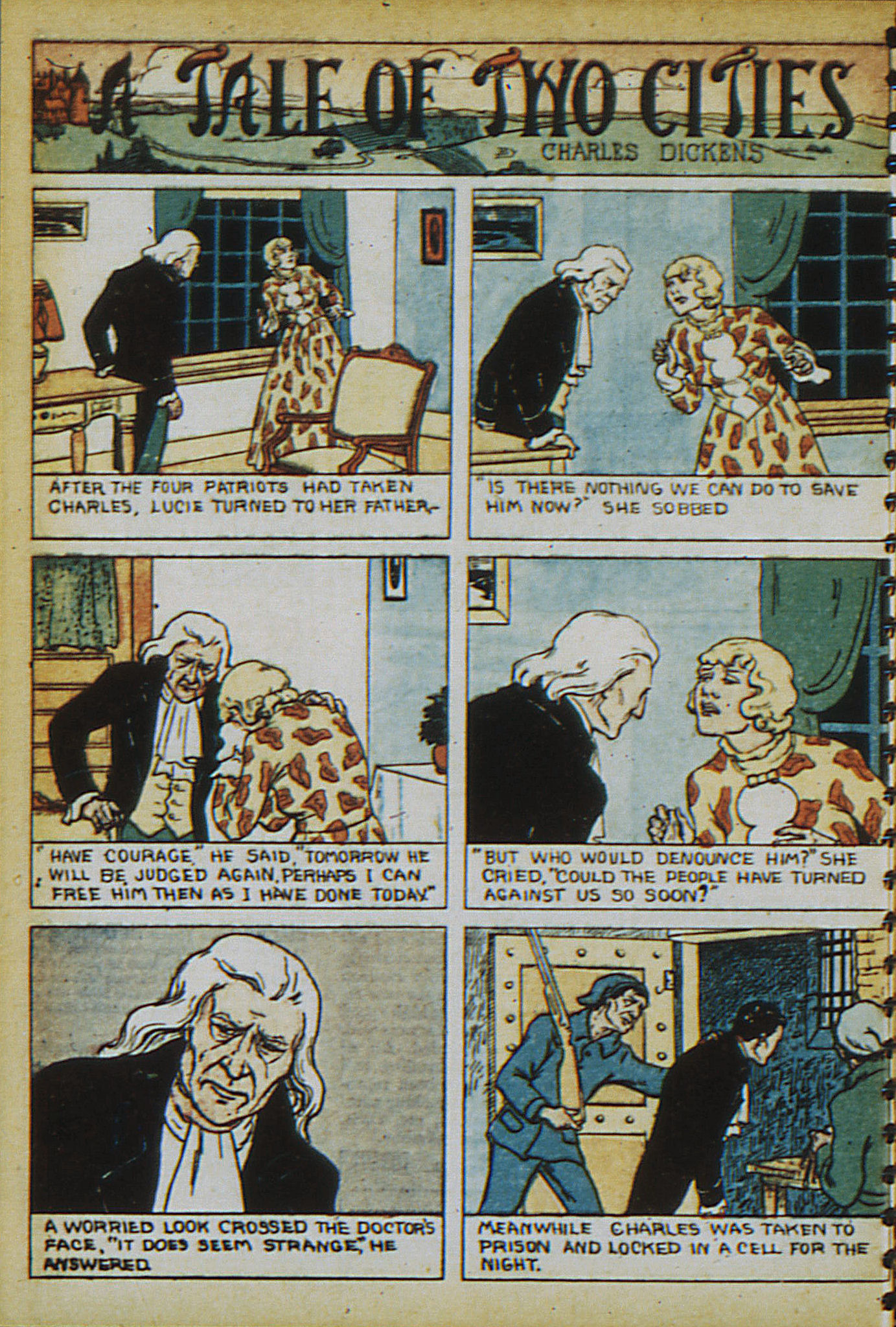
Russell Cole has 5 features, all humorous. “Goofo the Great” by Cole as Alger is a one page and one joke comic in color. Goofo goes to a fancy dinner event at the Explorer’s Club and finds that he doesn’t fit in. He also has a one panel comic in color on an ad page with Whitney Ellsworth suggesting it’s a good habit to read the ad pages. Nothing like promotion!
“Ol’ Oz Bopp,” a continuing character by Cole, as Alger is a two-page humorous comic in black and white and red with some variations of tan or brown. It’s difficult to tell from the digital copy I’m working from. On his way to pick up pork chops Bopp gets waylaid by reminiscing about the way it was.
“Shifty Smith” by Cole as Alger is an extraordinary 8 pages of what is basically a one-line joke. It’s also in color, another interesting aspect. Cole’s penciling is excellent and evocative allowing many of the panels to have no dialogue yet moving the story along clearly. Shifty steals a purse and eludes the police in a number of disguises and at the end Professor Smith is grabbed by the police believing him to be Shifty.
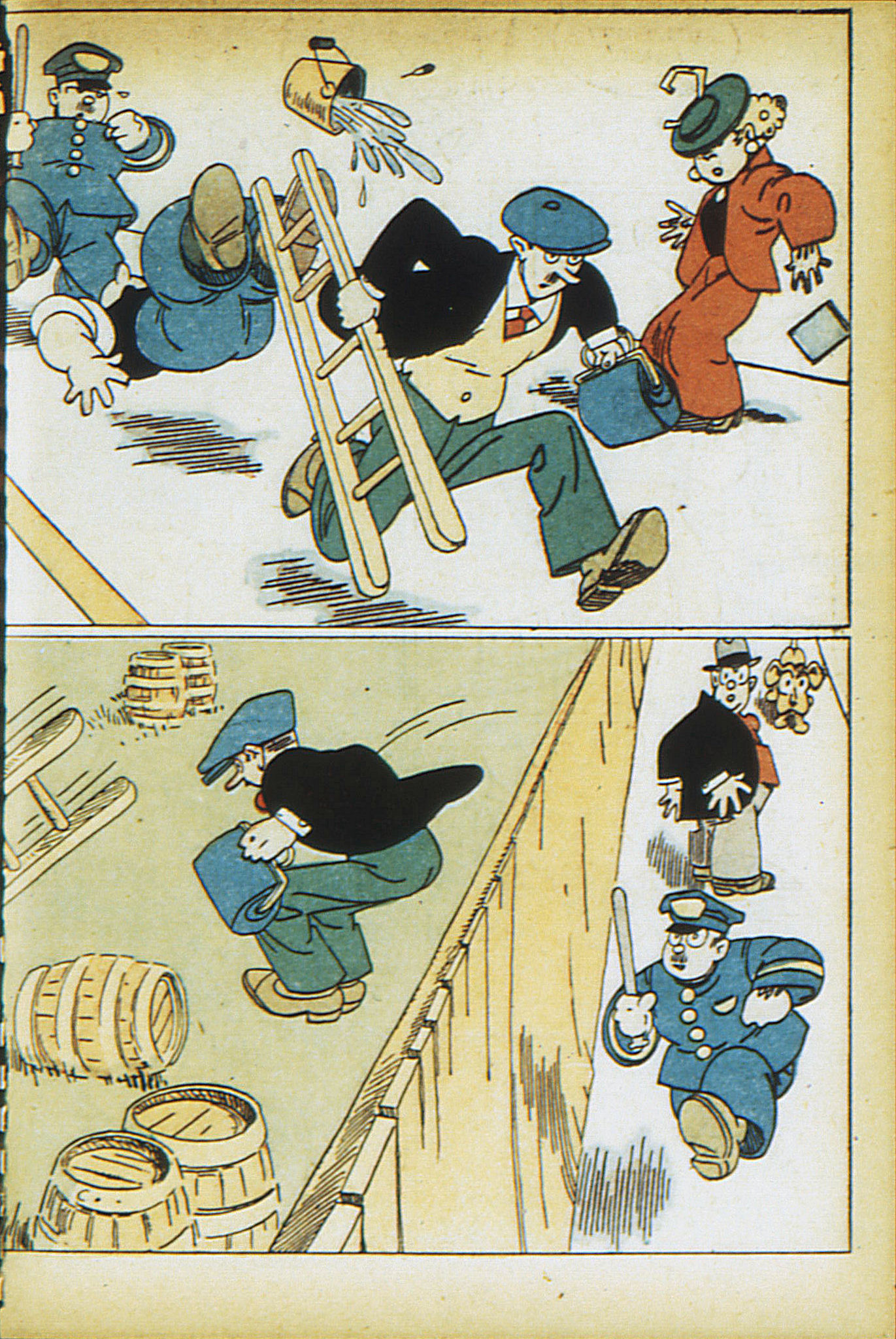
The fifth feature by Cole as Alger, “Alger’s Variety Show,” is a one-page joke in 7 panels also in color. I didn’t get the joke. It is interesting that Cole’s features are in color as opposed to some of the more dramatic comics in black and white and red. Were his comics delivered sooner than the others? Did he have some kind of in or position that allowed him to have so many pages and in color? I’m going to keep this on my radar as it is intriguing.
Siegel and Shuster have their continuing feature, “Federal Men” with four pages in color. In this episode, Steve Carson does not appear and Shuster’s artwork looks somewhat unfinished to me as if it was a draft–not his usual meticulous style. The storyline isn’t quite solid either, as if someone threw it together or suggested it or it was done hurriedly. However, it does promote the idea of the Junior Federal Men Club since the boys’ club in their eagerness to find crooks do find a gang of counterfeiters. It is immediately followed by two pages detailing the Junior Federal Men Club and encouraging readers to join. The organization as detailed has to be written by MWN. From all the research I have done into his military history and reading his books and essays on the military, the way the club is organized is classic MWN. He was still commanding men in one way or the other.
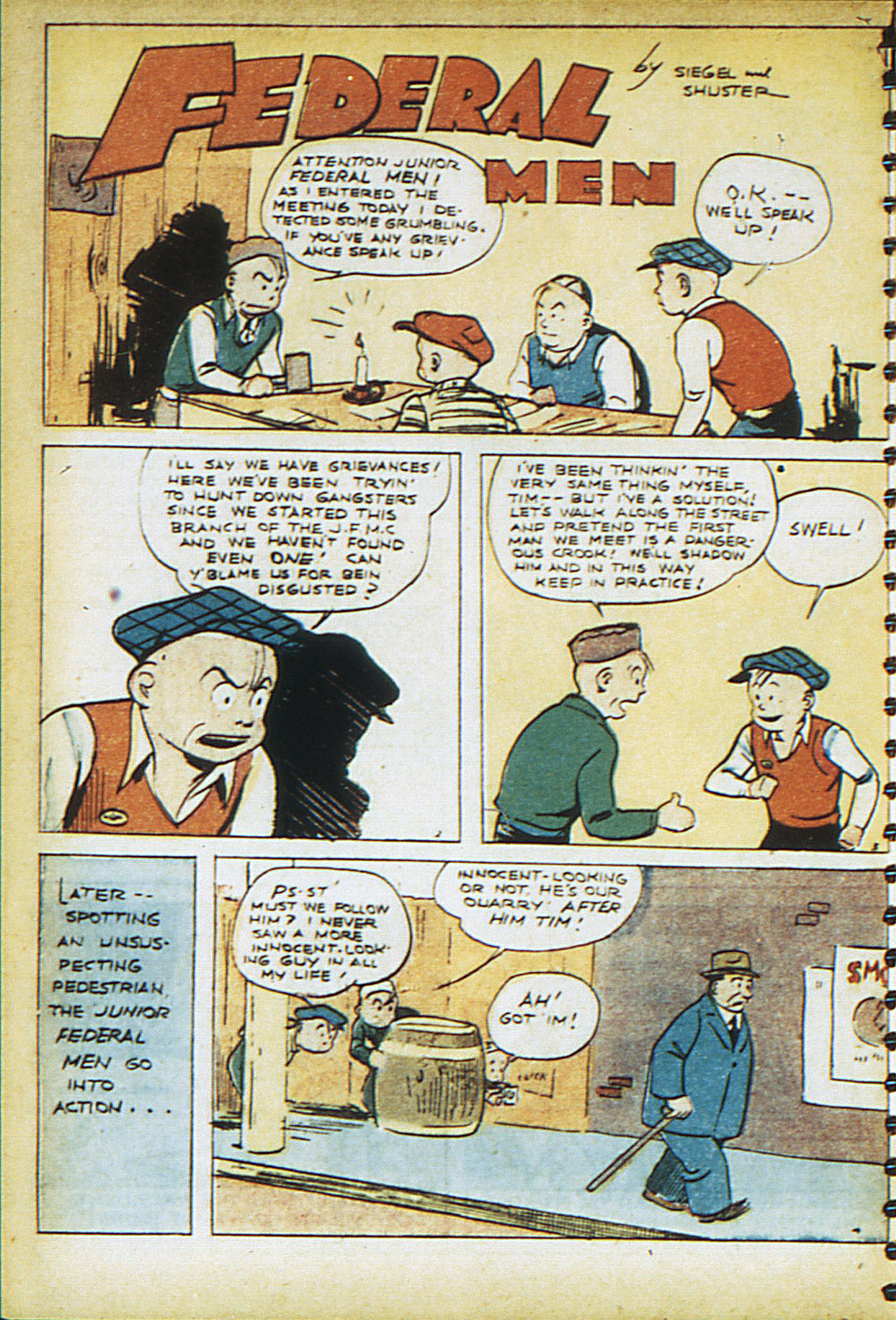
Ray Burley began drawing the continuing “Cal N Alec” and “Don Coyote” comics in New Adventure #19. These comics were originally drawn by R. G. Leffingwell as “Sir Loin of Beef” and “Sagebrush n’ Cactus” for New Comics #1-4. Bill Patrick continued with these comics in New Comics 5-16 but they were renamed. “Sir Loin of Beef” became “Don Coyote” and “Sagebrush n’ Cactus” became “Cal n’ Alec.” Some of the characters names remained. Leffingwell or someone renamed “Sir Loin of Beef” as “Evidence Eddie” for Mahon and Cook’s The Comics Magazine #1 and #2. Neither Leffingwell nor Patrick seems to have been affiliated with one of the studios so who created these comics?
In this issue “Cal n Alec” is in black and white. A stranger appears with a young boy at the campsite and asks for food. It is discovered that the stranger is a kidnapper when the young boy throws a dead snake into the midst of the group. Trust me, it makes more sense as a comic. “Don Coyote” is also in black and white with the dialogue in pseudo Shakespeareanese. The three compatriots enter a tavern as they are hungry. When they ask for buttermilk a bully threatens Don Coyote but young Hash crowns him with a pitcher of same. The penciling is good and the story is clear even with the silly dialogue. It was likely aimed at the younger demographic.
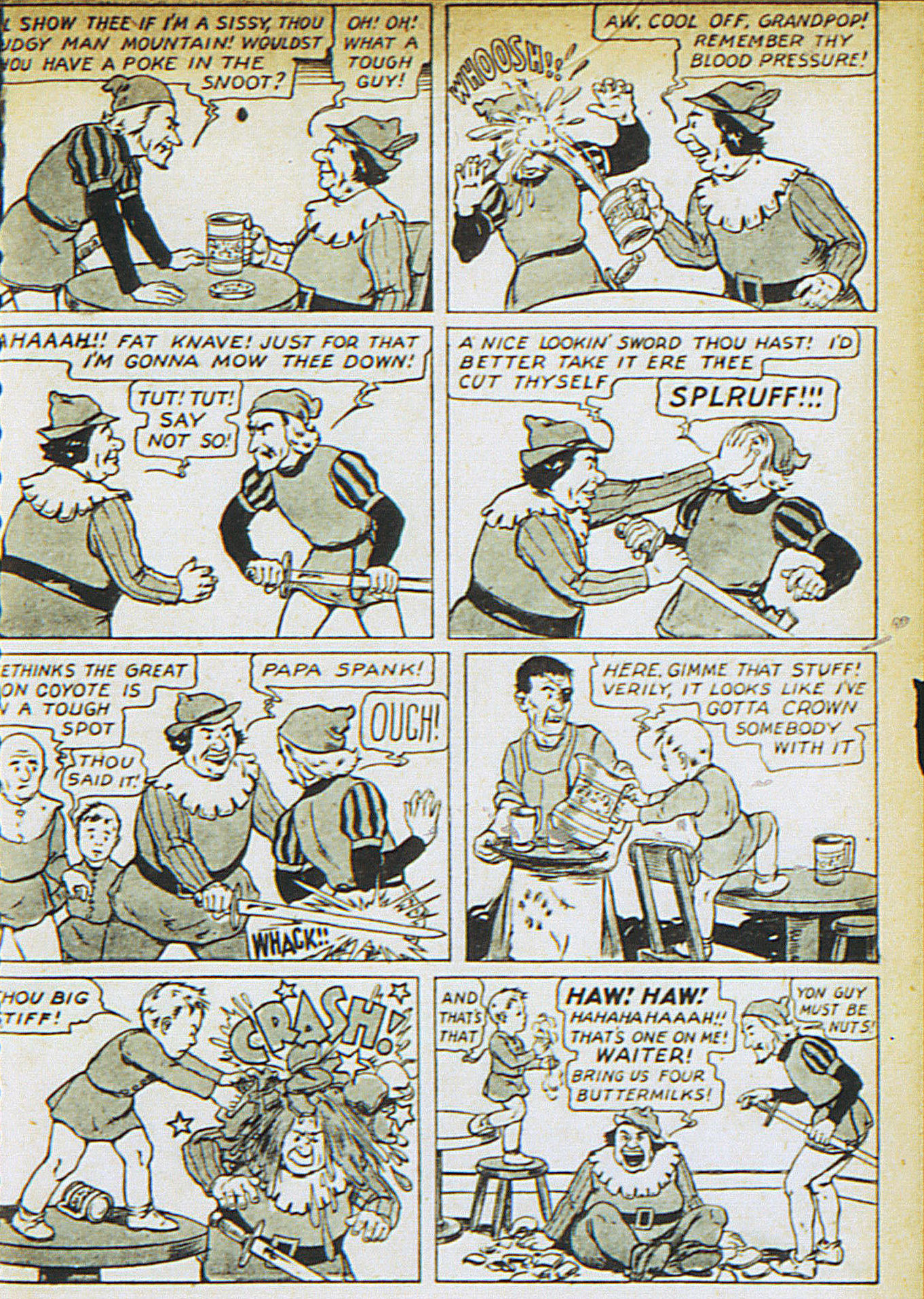
Whitney Ellsworth and Vin Sullivan in addition to their duties as associate editors have one feature each. “Jonah Jones” by Whitney Ellsworth is a two-page comic in color. This is the only appearance of this character. Jones doesn’t want an insurance policy but slips on a banana peel and ends up in the hospital for 6 months. He takes out an insurance policy on the banana salesman–a stereotyped Italian–and proceeds to thrash him with his cane.
“Laughing at Life” by Vin Sullivan is a regular feature and consists of 2 pages in color of one panel jokes. They’re typical for the period.
“Chikko Chakko,” a regular feature by Ellis Edwards is two pages in color. Chikko appears to his two friends who thought he was dead. When Chikko goes to surprise his girlfriend Loopie, he discovers Pedro consoling her. Chikko gets rid of him promptly with Loopie explaining Pedro was consoling her. The penciling is excellent and the story moves quickly. I’m still on the fence about the stereotyping in this comic.
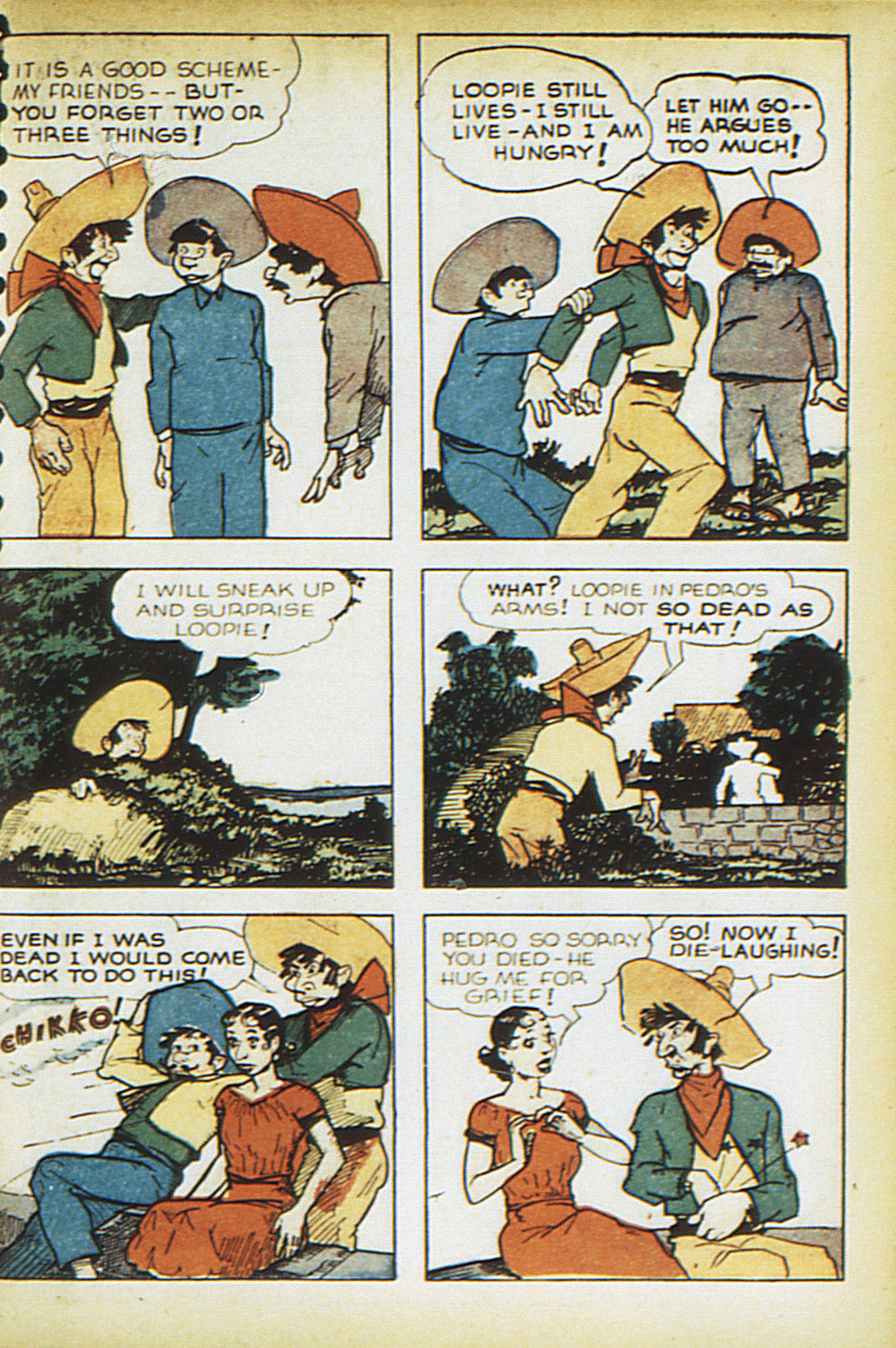
Bill Ely has two continuing features “Dale Daring” and “Nadir Master of Magic.” Dale Daring, a two-page comic is in black and white. In this episode the marines arrive to rescue Dale, her father, Captain Brewster and Ali from the Valley of the Lost Ones. I’m a big fan of Ely’s style and his scripts are usually tight with lots of action.
“Nadir Master of Magic” is four pages in color. Ely’s penciling and style comes across especially well in color. In the continuing story of the search for the famous pearl Nadir chases Job to a ship using his magic crystal and gets on board. He is discovered and thrown overboard. The dialogue is a little clumsy in places but otherwise it’s a good story with lots of action.
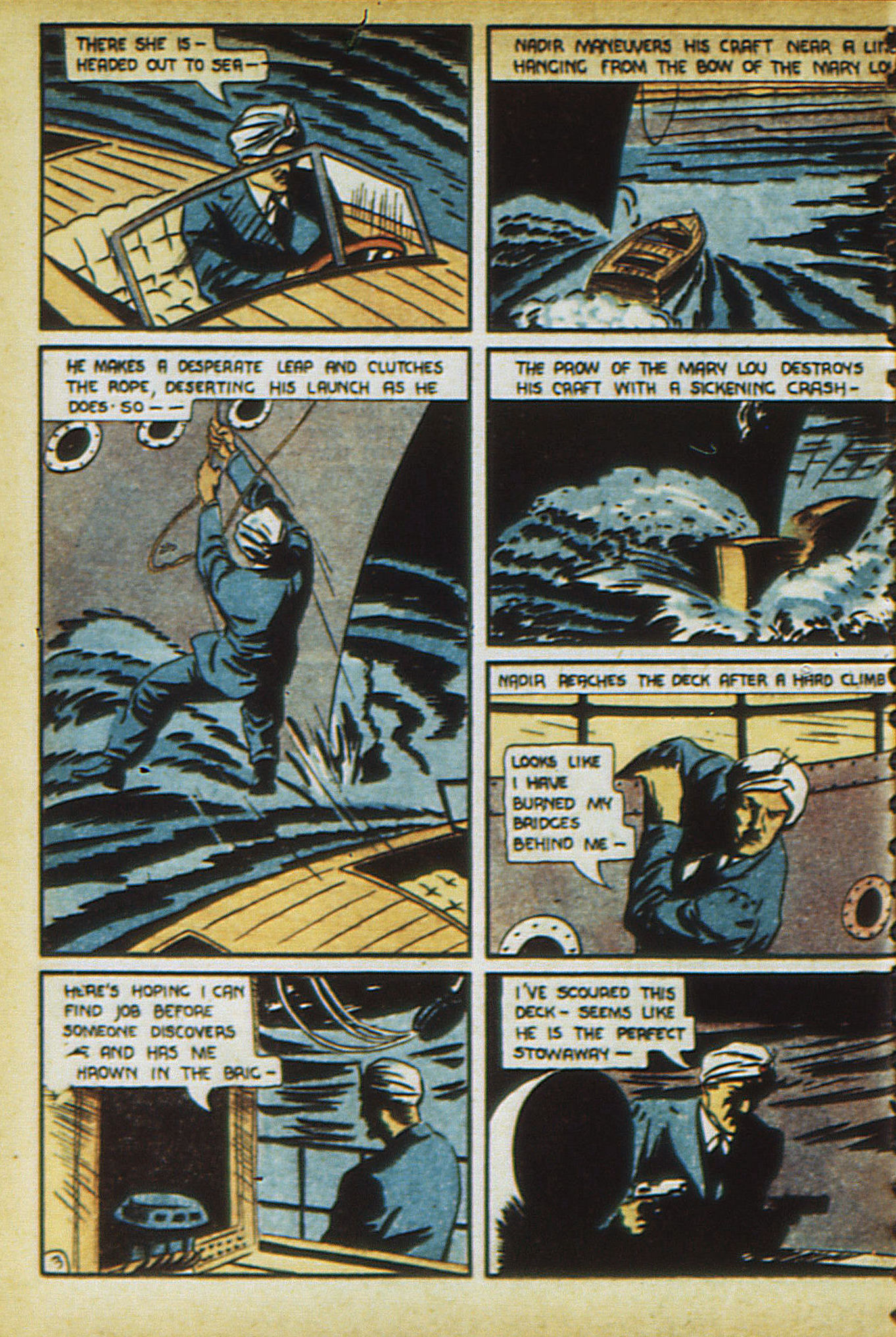
Gil Fox appears with “Winnfield” a one-page comic in black and white with no dialogue except for the cries of a drowning man. It’s a testament to Fox’s artistry that the entire story is clear and quite funny without any dialogue. His penciling is superior.
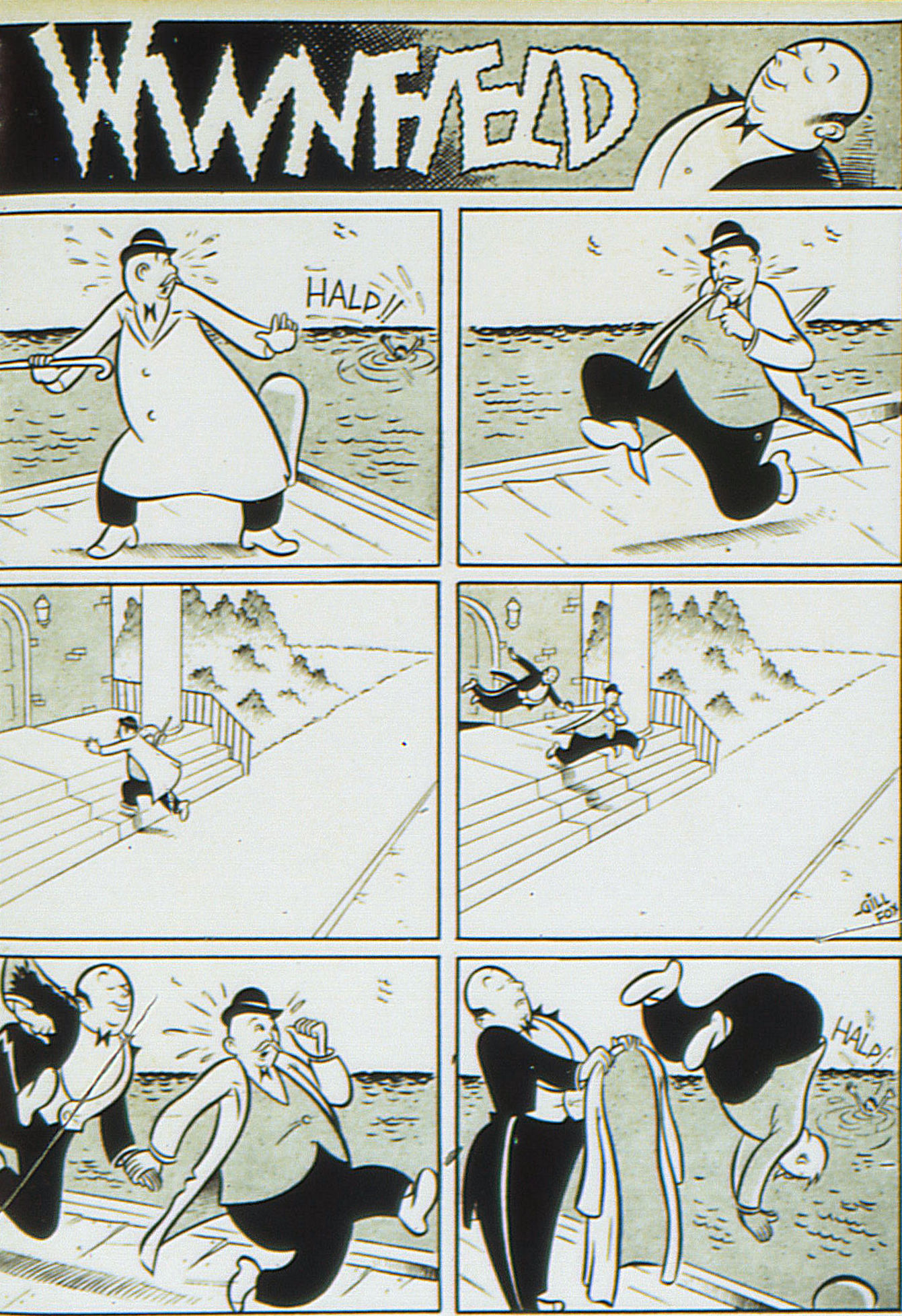
There are only 3 non-comics features besides the entreaty to join the Junior Federal Men Club features. I.W. Magovern’s regular “Movies” two pages about the latest movies with a photograph of the Ritz Brothers in “Life Begins in College” and Joe E. Brown in RKO’s “Fit for a King.” It’s full of tidbits about movies and stars like Joel McCrea, Ginger Rogers and Katherine Hepburn and written with a snarky attitude as if Ms. Or Mr. Magovern had themselves a nice martini lunch. Enjoy!
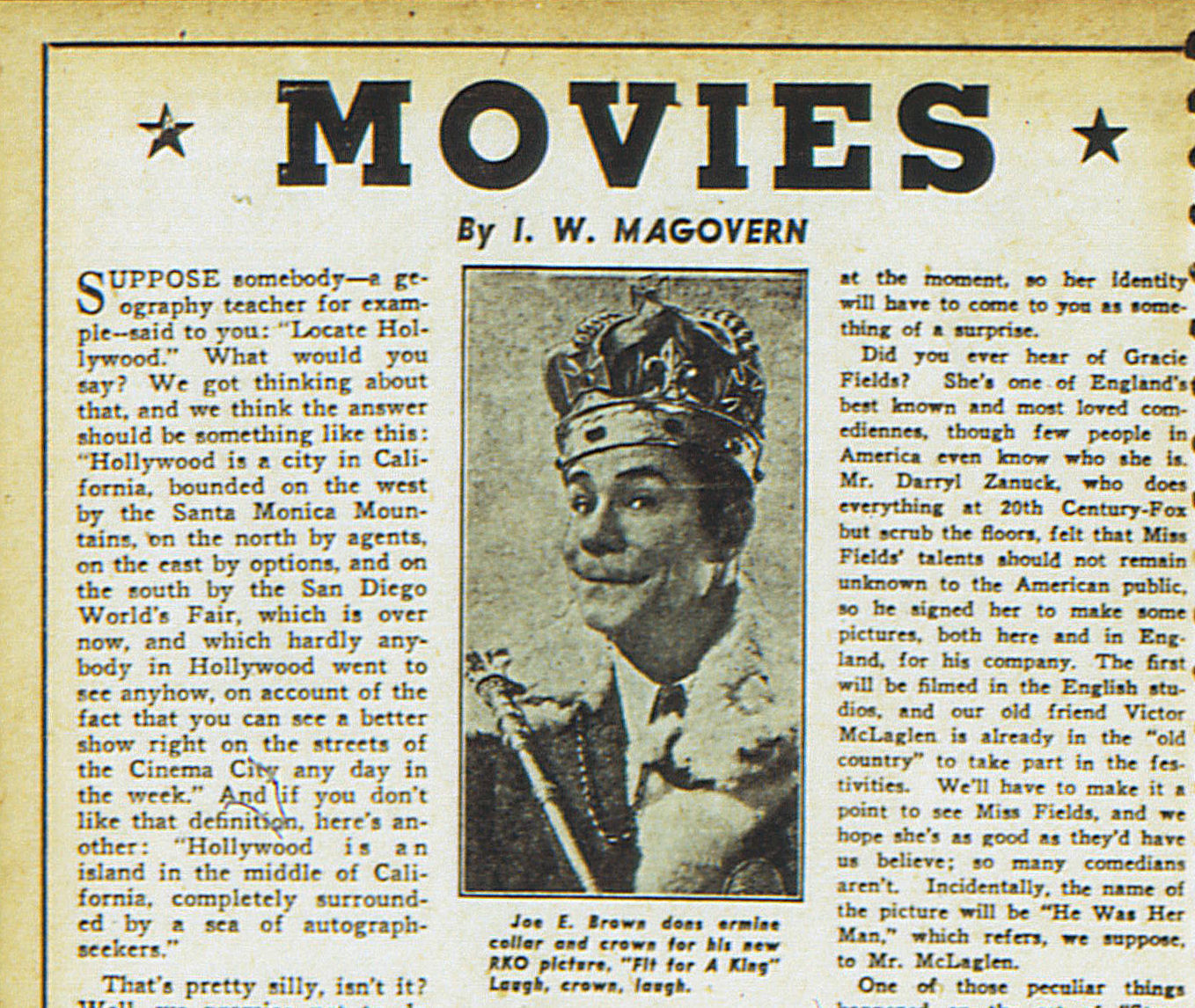
There is a one-page feature on the explorer David Livingstone with two black and white drawings oddly entitled “Are You Handicapped” by Richard Speed. And a one-page for the International Good Neighbor Club by Ann Leslie encouraging readers to correspond with members from around the world. The beginning paragraph puts us in that time and place—“In these troubled days, with war clouds hovering menacingly over Europe and Asia, the work we have begun in our International Good Neighbor Club, seems more important than ever.” It’s a moment of sober thoughts in the midst of the comics.
In spite of what appears to be money problems this magazine is another solid publication with good stories and artwork from a regular group of contributors. It was most likely put together in late summer 1937.
Thanks to Doc DC, Comic Book Plus and Grand Comics Database.
